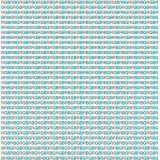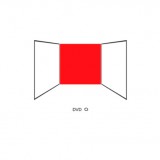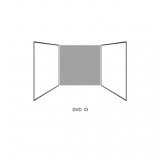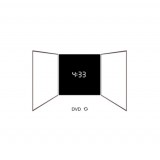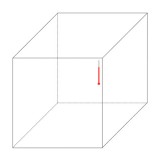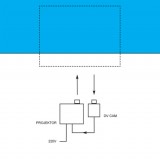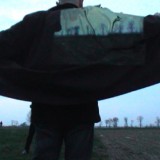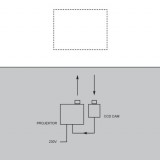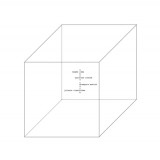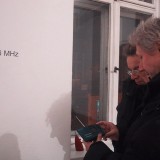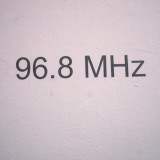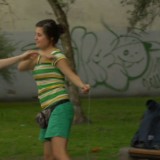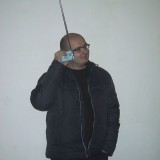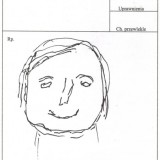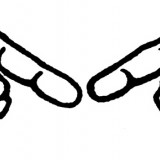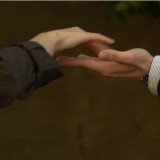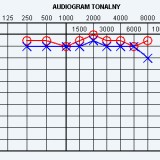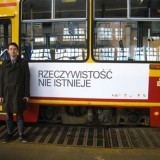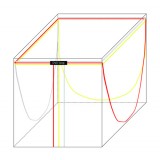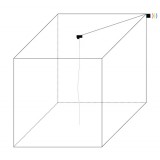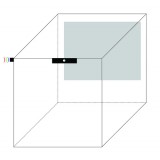Łukasz Ogórek
Born in 1979 in Piotrków Trybunalski. In 2003 he graduated from the Academy of Fine Arts in Łódź. He studied in the Studio of Photography and Video Image run by Konrad Kuzyszyn and he currently lectures in the Multimedia Stuido. In 2002 he received a bursary from Nottingham Trent University in the UK and in 2008 the bursary entitled Radius, from the Alexandria Contemporary Arts Forum in Egypt. He mainly expresses himself in video and audio art, however he also creates photographic images and installations. In Łukasz Ogórek’s art, the conceptual lesson intermingles with action in the convention of the absurd, which is close to Dadaism. These are not spectacular actions, more important than their visual form is their analysis of reality and their play upon the conventions of everyday life and art.
In his diploma work of a scholarly title: Studies on the academic notion of the fine arts he undertook a game both with the structure of the visual message and with the methods of academic teaching. The work, as usually happens in art schools, consisted of both a practical part (video entitled cbcbc) and a theoretical. In the video work the artist built an image out of two registrations – one made using a totally open diaphragm and the other on a totally shut. This way of filming reality led to the emergence of two abstract images – black and white. The artist showed in this way that the image of reality depends on the way it is registered. To what extent it will be realistic, to what extent it will be abstract, all depends on the settings of the registering tool. As a result of the overlapping of both extreme situations (the image from the totally open and totally shut diaphragm) in various intensity – there emerged a grey image of a pulsing, dynamic structure. The artist was able to achieve the effect of abstract painting, using a mechanical media. Here it brings to mind Kazimierz Malevich with the black and white square. We will find other echoes of his concept of art in Łukasz Ogórek’s art, too. As part of the presentation of the theoretical part, four people read notes made by Ogórek during all classes that he attended during his studies. Notes on various subjects which were to complement the thorough artistic education of an Academy of Fine Arts’ student, contrasted with one another and turned out to be an absurd mixture of information which existed next to each other rather than with any kind of relationship. Łukasz Ogórek confronted therefore the way of teaching with its effect – the silhouette of the graduate – which was himself.
Łukasz Ogórek undertook a reflection on the way the digital image emerges, how it is emitted and received, in the work RGBRBGR (2004) in which he made a permutation of the set of the structural components of the screen phenomenon matrix. In the work Landscape (2004) he made a no-screen projection. The event took place in the open environment at sunset. The camera was registering the landscape, whose image then was transmitted to the projector. The projector emitted the image of the landscape onto the real landscape which was being registered at the same time. The projection took place, but was invisible. It was revealed when someone showed up between the projector and the landscape, and became a human screen. A similar principle was repeated, although this time inside of the gallery in the interactive projection Image (2005). The projector emitted the registered image towards the area taken in the camera frame. The registered and at the same time transmitted image was modified because of the movement of people between the projector and the screen. In both cases the viewer is an important element of the work. The artist made us aware, that art not only does not exist without the viewer, but also is differently perceived by each of us, therefore the message is modified.
Often in the relationship between the artist and the viewer there appears an intermediate – an art critic, that is a professional audience, who is supposed to make art more accessible to those who are less informed. Łukasz Ogórek invited four critics and curators with whom he had worked earlier: Magdalena Ujma, Jolanta Ciesielska, Jarosław Lubiak and Grzegorz Musiał to participate in the installation which he created in the Wschodnia Gallery in Łódź entitled Łukasz Ogórek (2007). Łukasz Ogórek asked them to talk about him and his projects. The statements circulated on the airwaves and the viewers’ task was to find them, searching for appropriate frequencies using radios that they brought to the gallery. The request to bring radios to the gallery engaged the viewer. Without them the project literally could not have been received. Are the critics, curators and so called ordinary viewers “on the same frequency”? What is the role of the curator in the emergence of the work? How much does the artist’s work gain by this, also in a financial sense? How many gallery owners will be convinced to exhibit it when it will be piercingly analysed by well known critics?
Echo (2012) is also a work based on sound and interaction and it was an installation or rather install-action, presented together with Daniel Koniusz as part of Urban Ecologies in Łódź. A necessary condition for the installation to function was the participation of the viewers. One had to take a device producing sound into one’s hands – it consisted of copper plates which reacted to the touch and were attached to electricity. Through interaction with other people, they were used to play a common composition. This hybrid instrument is possible thanks to good conductivity of both copper plates and human bodies. What is going to happen during activating the installation is a regular transfer of electric charges. The technology is simple and is a pretext for the collective generating and interpreting of sounds. Just like musicians in the orchestra have to observe the conductor and each other in order to sound harmonious, we will try to play a melody negotiated among the participants, which is going to show how important ‘social warmth’ is in the process of the emergence of music. – wrote the artists.
Apart from the listed projects, it is worth recalling the installation from the Łódź Biennale (2004) – a room in which for the entire time of the exhibition the temperature was 36.6 C. As part of the project Is the sound audible? (Festival Tansmana, Łodź Philharmony 2012) Łukasz Ogórek made a gong based on the scales from 250 to 8000Hz which corresponds with the scale of the tonal audiometer used for the examination of hearing. The artist referred to the possibilities and borders of our perception not only in the sensual but also symbolic sense. During the exhibition Mentality in an installation entitled Coexist (Łódź Biennale 2006) he placed religious symbols onto a window – a cross, star of David, half-moon and the symbol of Hinduism. The image from outside the window was only visible through the shape of the sign, the rest of the window was covered. Religions are filters through which we see the world and through which we perceive it. The problem of mysticism and the attempts to achieve unity with a god-like absolute he undertook by using AV equipment in the installation entitled s (the search of suphi*) from 2008, inspired with suphism which he had a chance to come across during his residency in Egypt.
Łukasz Ogórek’s art connects an analytical, post-conceptual approach with sensuality, in which ways of seeing stops to be the basic tool to perceive art. The majority of Ogórek’s projects do not have material form, they are temporary events and their existence is often determined by the presence and action of the viewers and their individual interactions. The characteristic of his works is their performativity. It is difficult to see the documentation from these actions and on the artist’s website we find instead graphs and schemes explaining the principles of the work. But we also come across the artist’s portrait – a moving, naïve and at the same time warm drawing, made as if it was drawn by a child. The author is the artist’s Dad – Michał Ogórek, a doctor. And the drawing was made on a prescription form and presented during a group show C.D.N. in 2008 which motivated the topic of the relationships with fathers.
Łukasz Ogórek does not create images of reality, but tries to discover its rules, examines the relationships between what’s real and what’s abstract, between creating and receiving a message. How certain are we of the grounds of our existence? Are we able to believe the text which the artist wrote on one the trams in Łódź during the Fokus Łódź Biennale 2010:
Reality does not exist.
Anka Leśniak
more at the artist's web site:
http://www.lukaszogorek.asp.lodz.pl/


